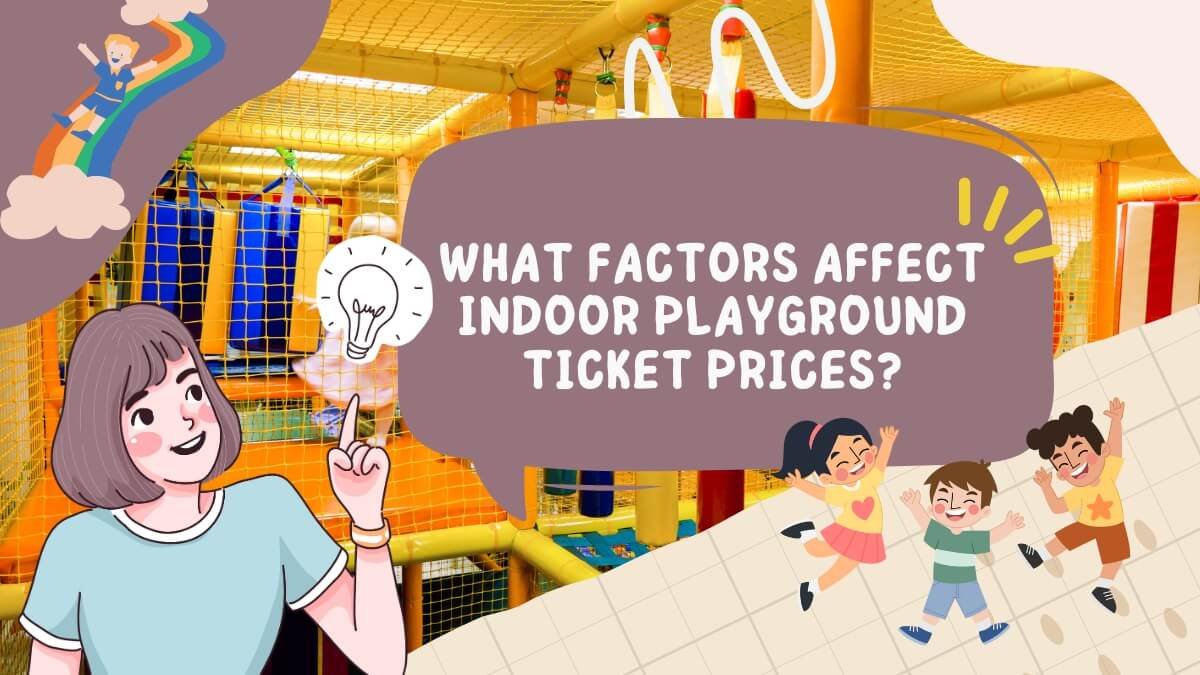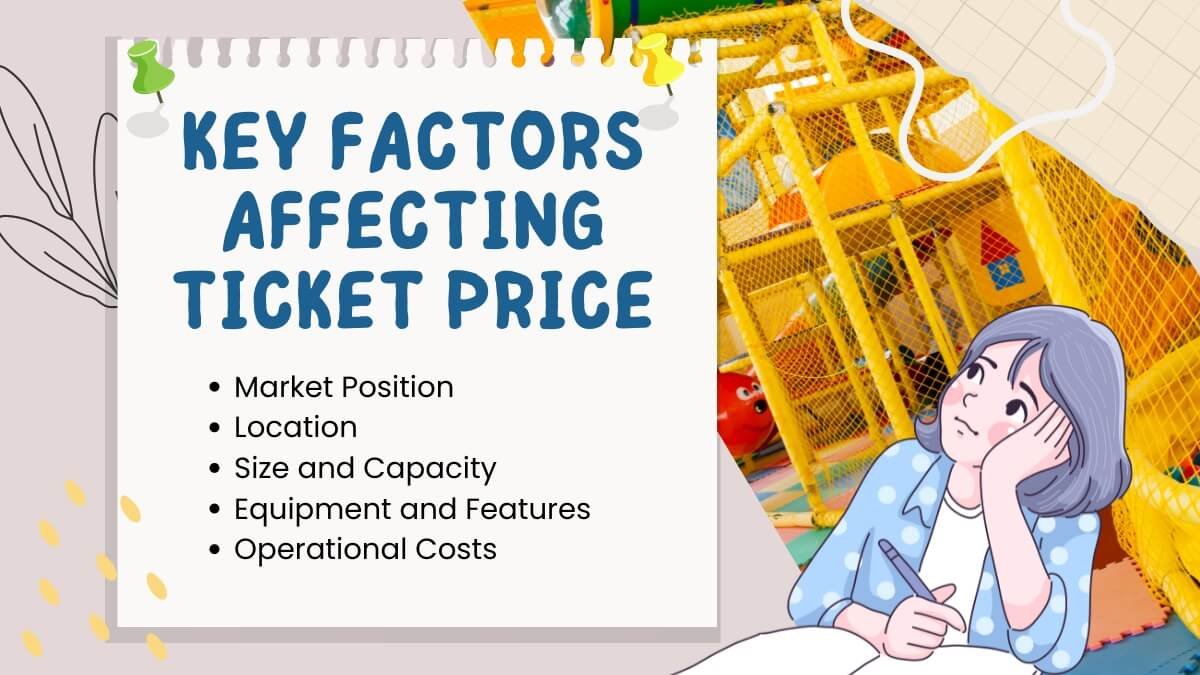As an interior playground operator, have you ever wondered how to set the perfect ticket price to not only attracts families but also covers your operational costs and generates profit? You are not alone. Many venue owners struggle to find the right price that is both affordable and profitable. The challenge is balancing factors like your location, the size of your playground, the diversity of your equipment, and how much it costs to operate your playground. If you price your tickets wrong, you will have unhappy customers, fewer people come, and/or you will lose money. But don’t worry, I’m going to show you the factors that affect ticket prices so you can make better decisions and make more money.
There are many factors that affect indoor playground ticket prices. Not only do these factors influence the initial investment, but they also determine ongoing operational expenses. Here are some of the most important factors that will determine how you should price your tickets:
- Market Position
- Location
- Size and Capacity
- Equipment and Features
- Operational Costs

Now that you understand some of the factors that can affect ticket prices, let’s take a closer look at each one and how they influence your pricing strategy.
Key Factors Affecting Ticket Price
Market Positioning
Market Position is the first factor that determines how much you can charge for your interior playground. If you position your playground as a premium experience—unique, high-end features, exceptional safety, and a superior environment—you can charge more for tickets. If you position your playground as a budget-friendly option, you need to price tickets more competitively.
Who you are, who you target, and the overall experience you want to give your customers will determine your pricing structure. For example, a luxury family entertainment center in a high-end neighborhood will have different pricing than a community-focused indoor playground in a suburban neighborhood. Understanding your position is crucial to setting a price that reflects the value you deliver to your customers.
Location
Location is another biggie that has a major effect on ticket prices. An interior playground in a dense urban area will naturally get more traffic because it’s easy to get to and in close proximity to families, schools, and other things to do. That said, higher rent often comes with these prime locations. To make up for the higher rent, operators often charge higher ticket prices. The good news is that in high-traffic locations, people may be willing to pay more because of the convenience and accessibility.
On the other hand, if your interior playground is in a less populated or more remote area, your rent is probably lower. While this can result in higher profit margins, the downside is you have fewer people to attract to your location. In this case, you may need to have competitive pricing to get people to drive out to your place when they could just as easily go to a more visible or accessible location. The trick is to balance location costs and pricing to make sure you’re profitable in the long run.
Size and Capacity
The size and capacity of your interior playground directly impact your ticket prices. A bigger playground with a higher capacity can serve more people at one time, which means you can potentially make more money. However, this also means you have higher initial setup costs because you have to buy more stuff, hire more people, and maintain a bigger space. You may have to charge more for your tickets to cover these costs.
A smaller playground may not have the same capacity, but your costs are lower, so you can be more competitive with your pricing. It’s all about finding the right balance between capacity and pricing to make sure you’re making the most money without sacrificing the customer experience.
Equipment and Features
The quality, variety, and uniqueness of your playground equipment play a significant role in ticket pricing. Premium indoor playgrounds that feature cutting-edge play structures, interactive digital experiences, or specialized zones (such as soft play areas, indoor playgrounds, ninja warrior courses, or trampoline parks) can charge higher ticket prices due to the added value these features provide.
On the other hand, a more basic playground with fewer attractions may not support premium pricing. People are generally willing to pay more for a better play experience, especially if it includes equipment that’s safe, durable, and innovative. Investing in high-quality, safe, and diverse equipment will not only make your playground better but also allow you to charge more.
Operational Costs
The costs to operate your interior playground, including payroll, utilities, insurance, maintenance, and janitorial, all factor into your overall ticket pricing. These costs can vary widely based on the size of your playground, the number of staff you have, and the equipment you have to keep up. Operators must carefully consider their operational expenses to figure out how to price their tickets to cover those costs and remain competitive in the market.
Labor is usually one of the biggest operational expenses, especially if you have staff to supervise, sell tickets, keep up your equipment, and work with customers. Plus, you have to regularly maintain and clean your playground equipment to make sure it’s safe and your customers are happy. You have to include these ongoing costs in your ticket pricing to stay profitable.

As we’ve discussed in this article, ticket pricing is not a simple formula. From market positioning and location to equipment and operational expenses, every part of your business plays a role in figuring out your price. Understanding these factors will help you make better decisions and come up with a price that makes sense for your target audience and your business.
How Location and Rental Costs Affect Indoor Playground Ticket Prices?
Location is arguably one of the most critical factors influencing indoor playground ticket prices. Playgrounds situated in urban centers typically benefit from higher foot traffic due to their proximity to families, schools, and amenities. While this increased visibility can drive more customers through your doors, it also comes with higher rent costs, which can be substantial in prime areas. To cover these expenses, operators in urban locations often set higher ticket prices, knowing that the convenience and accessibility of their location justify the cost for visitors.
By contrast, indoor play centers in suburban and rural areas often enjoy lower rent. That’s great for your indoor playground startup costs. The downside is you might not have as many kids to work with. In order to get enough kids in your place, you may have to charge a lower price for admission even though your rent is lower. The trade-off here is between reduced rent and the challenge of drawing enough customers to sustain profitability.
In short, a great location can help you get more kids in your place and charge more money, but it also means you need to pay close attention to your rent to make sure you stay in business. You have to balance all of these things to make an indoor play center work.
What Are the Best Strategies to Attract Customers During Off-Peak Times?
Running an indoor play center isn’t just about the weekends and holidays. During the week, especially in the morning and afternoon, it can be dead. To keep the money coming in, you have to find ways to bring kids in during the off times. Here are some of the best ways to do it:
Special Offers and Discounts
- Off-Peak Pricing: Offer discounted rates during slow times to get people to come into your place. For example, if you offer “Happy Hour” pricing, you’ll get more people in during the week.
- Package Deals: Create family packages that include multiple visits or combine playground access with food and beverage options at a discounted rate.
Themed Events and Activities
- Holiday Celebrations: Have special events at your playground around holidays like Halloween or Christmas, which can draw families looking for festive activities.
- Character Meet-and-Greets: Host special events featuring popular characters or mascots, providing unique experiences that can entice families to visit during off-peak times.
Community Engagement
- Local partnerships: Partner with local businesses to offer joint promotions, such as discounts for families who visit both an amusement park and a nearby restaurant or store.
- Community Events: Host community-focused events, such as charity events or educational workshops, to engage local families and create a sense of community involvement.
Enhanced Amenities
- Food and Beverage Options: Adding a café or snack bar can encourage families to stay longer, increasing overall revenue. Offering food specials during off-peak hours can also attract more visitors.
- Provide Comfortable Spaces for Parents: Create areas where parents can relax while their children play, such as a coffee bar with Wi-Fi. This can make the playground more inviting and keep people playing for longer.
Marketing Strategies
- Social Media Engagement: Use platforms like Instagram and Facebook to promote off-peak specials and events. Encouraging parents to share their experiences can increase awareness through word of mouth.
- Email Marketing Campaigns: Send targeted emails highlighting upcoming events or exclusive offers during off-peak times. Personalized messages can be effective in engaging your existing customer base.
Flexible Scheduling
- Extended Opening Hours: Consider extending opening hours on certain days to accommodate families who may prefer to visit at a different time.
- Booking Incentives: Offer discounts to families who book in advance during off-peak hours, ensuring more predictable traffic.
Conclusion
Setting the right price for your indoor play center is part art and part science. By paying attention to things like where you are, how big you are, how much stuff you have, and what it costs to run your place, you can figure out how much to charge to make your customers happy and make money for your business. Where you are is the most important thing that affects what you can charge. You have to balance your rent with how many kids you can get in there to make money.
If you need help with custom indoor playground equipment or want to talk about how to price your interior playground, we’re here to help. We have great stuff, we’re safe, and we’re not stupid expensive. We’re here to help you be successful. Email me at info@leboplaycn.com or visit our website at leboplaycn.com to learn more about how we can help you.

